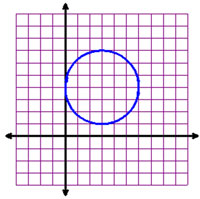
How many lines of symmetry does a parabola have?
A. One
Correct! There is only one line that divides a parabola in such a way that one side is the mirror image of the other.
B. Two
Incorrect. The ellipse and the hyperbola each have two lines of symmetry, but the parabola has only one.
C. Four
Incorrect. There is only one line that divides a parabola in such a way that one side is the mirror image of the other.
D. Infinitely many
Incorrect. The circle has infinitely lines of symmetry, but the parabola has only one.
Which statement is an accurate description of the lines of symmetry for a hyperbola?
A. There is one line of symmetry and it goes through the vertex.
Incorrect. This statement is a partial description for the line of symmetry for a parabola.
B. There are two lines of symmetry, they are perpendicular to each other and intersect at the vertex.
Incorrect. There are two lines of symmetry and they are perpendicular to each other, but they do not intersect at a vertex.
C. There are two lines of symmetry, they contain the conjugate and transverse axes, they are perpendicular, and they intersect at the center.
Correct! This statement contains all of the important features for the lines of symmetry of the hyperbola.
D. There are infinitely many lines of symmetry and they all contain the center.
Incorrect. This statement describes the lines of symmetry for a circle.
Which statement is an accurate description of the lines of symmetry for the given figure?

A. There are two lines of symmetry, one vertical and one horizontal, that meet in the center.
Incorrect. The circle pictured has infinitely many lines of symmetry that all contain the center of the circle.
B. There are four lines of symmetry, a vertical, a horizontal, and two that are diagonal, and they intersect at the center.
Incorrect. The circle pictured has infinitely many lines of symmetry that all contain the center of the circle.
C. There are two lines of symmetry. One contains the major axis and the other contains the minor axis. They are perpendicular to each other and intersect at the center.
Incorrect. This statement contains all of the important features for the lines of symmetry of the ellipse. A circle contains diameters, not major and minor axes.
D. There are infinitely many lines of symmetry; they each contain a diameter and intersect in the center.
Correct! This statement accurately describes the lines of symmetry for a circle.
Which figure has two lines of symmetry containing the major and minor axes?
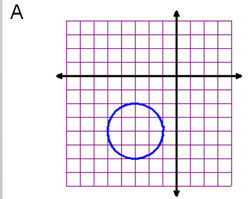 |
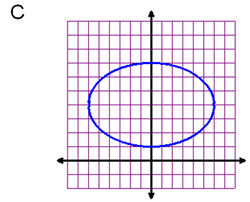 |
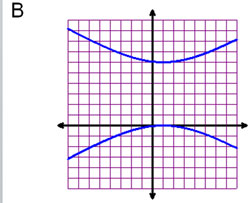 |
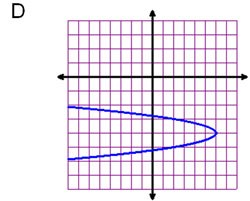 |
A
Incorrect. A circle has infinitely many lines of symmetry.
B
Incorrect. A hyperbola does have two lines of symmetry. However, they contain the transverse and the conjugate axes.
C
Correct! A hyperbola has two lines of symmetry. One contains the major axis and the other contains the minor axis.
D
Incorrect. A parabola has only one line of symmetry.